Set pieces are an integral part of modern football. So many fans may have heard about the design of corner routines, indirect free-kicks, or even throw-ins and kick-offs, but it may sound strange to discuss the design of direct free-kicks in a similar manner.
Everybody knows that there are technical tricks of direct free-kicks, such as how to kick the ball and the body position while moving and kicking, but in this scout report, we are going to explain the tactics used in direct free-kicks in this article.
The tactical part of direct free-kicks aims to distract the goalkeeper by making it difficult for them to see the ball or confusing them by provoking hesitation to move until the last moment; if that happens, the taker doesn’t have to put the ball into the furthest point in the goalmouth because the goalkeeper’s reaction comes later, essentially giving the kicker more room for imperfection. So, you don’t have to have Messi in your team to score a goal from a free-kick!
The traditional player beside the wall
We start with an old classic — one we may all know — which is the placement of a player in the path of the goalkeeper’s sight to make them unable to see the ball well until it passes, which makes their reaction come too late.
In the case below, Sergio Busquets stands beside the wall in the path of the goalkeeper’s sight in the first and the second photos. He moves away to let the ball pass when it comes closer in the third photo. At that time, the goalkeeper still hadn’t seen the ball, standing with no reaction until it got past. When he sees the ball and starts to move, as in the fourth photo, it’s too late to be impactful.
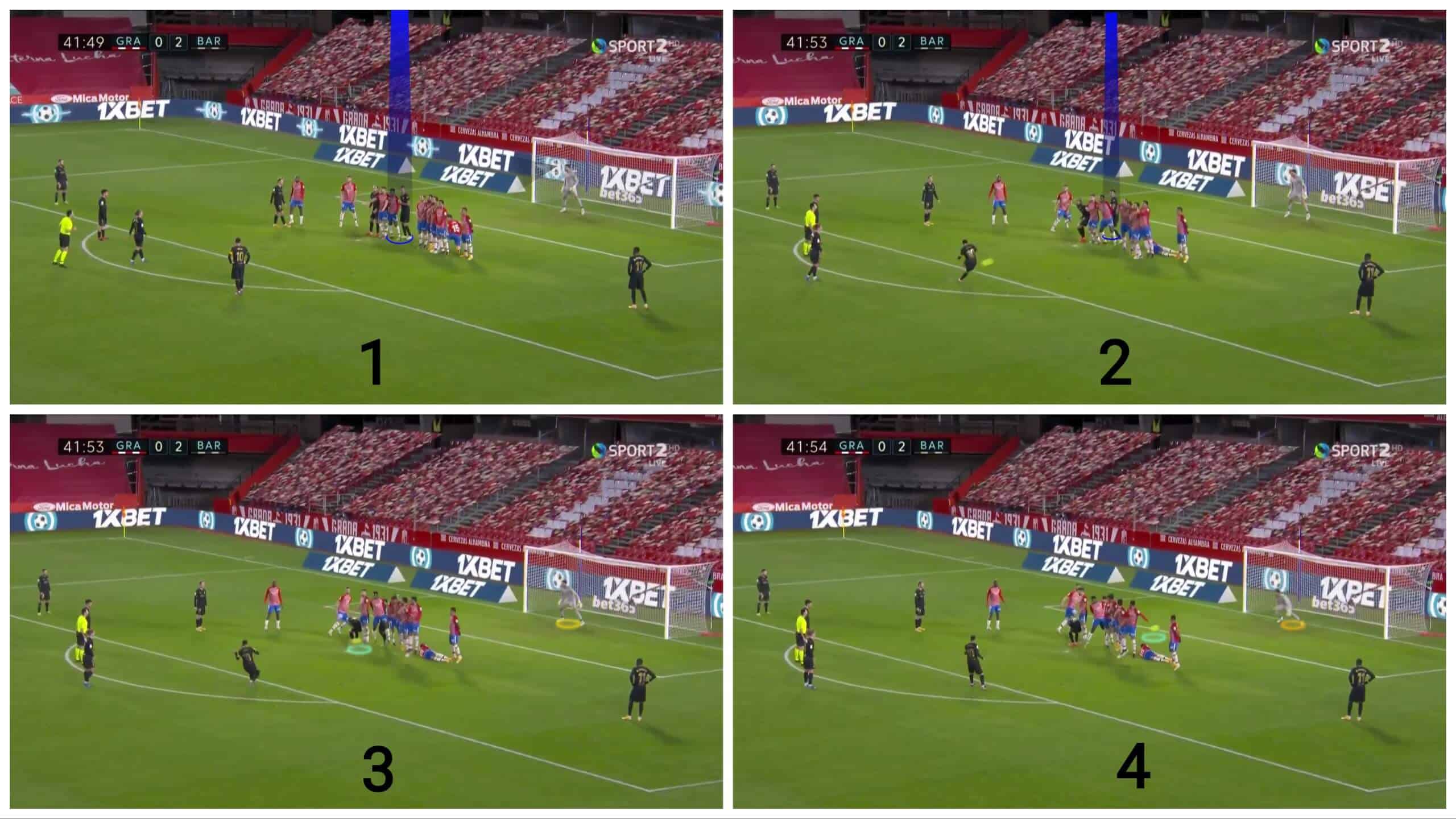
The result is a goal for Barcelona, as shown below.
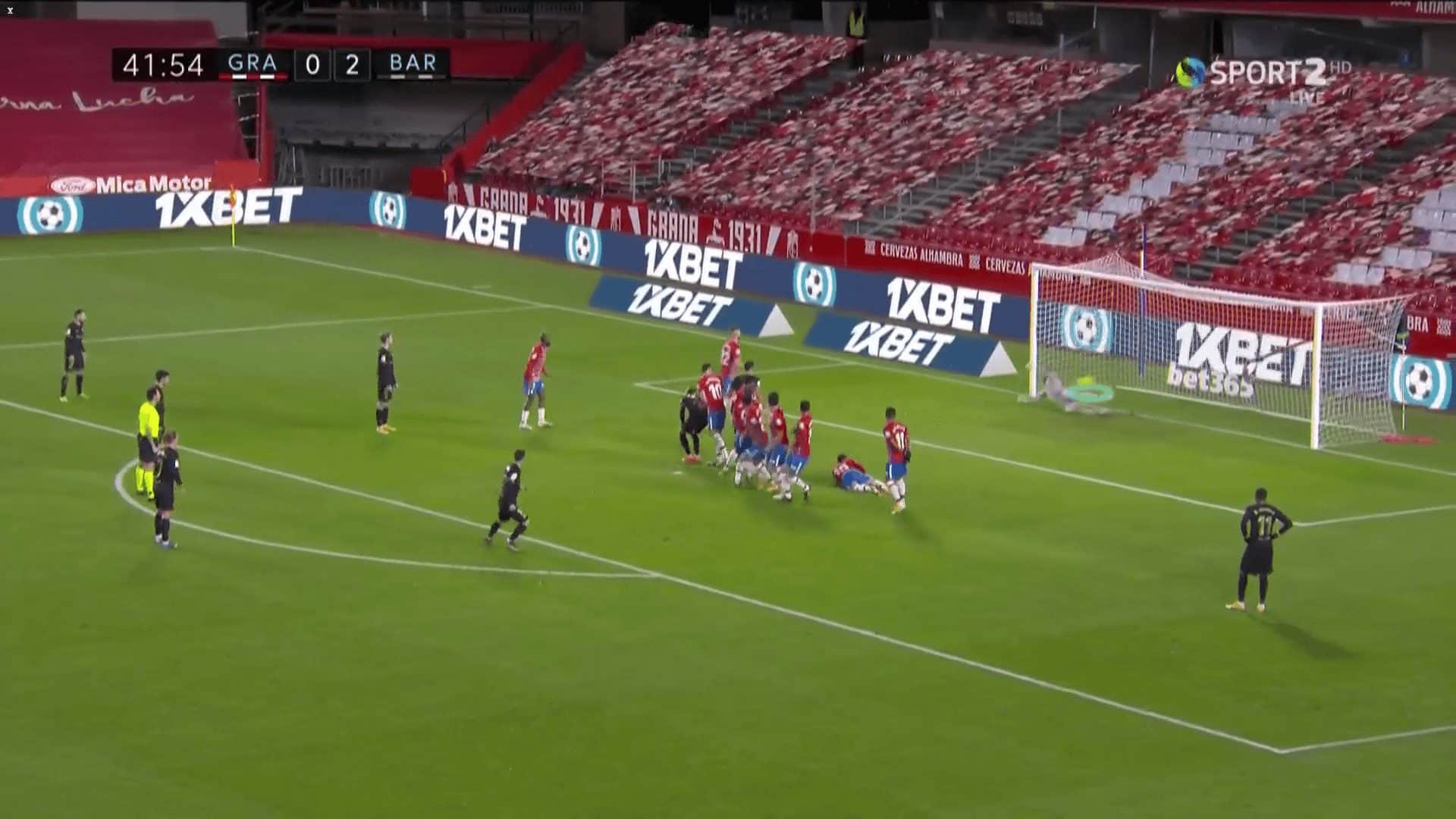
An attacking wall
This next trick has been perfected over time. A player becomes an ‘attacking wall’ because the defending team instructs a player to push away anyone who gets closer to the defending team. Hence, the attacking team puts players in a wall to ensure that the goalkeeper doesn’t see the ball, thus making his reaction later. The wall is also used to confuse the goalkeeper by making many distracting runs.
In the case below, it is clear that the idea is the same, but on a bigger scale to make it more difficult on the goalkeeper, as in the first photo. In the second photo, the wall starts to move away in different directions when the ball gets closer, while the goalkeeper still doesn’t see the ball and is even more confused, so he starts to move when the ball passes the attacking wall, as in the third photo. As shown in the fourth photo, he can’t get the ball, resulting in a goal.
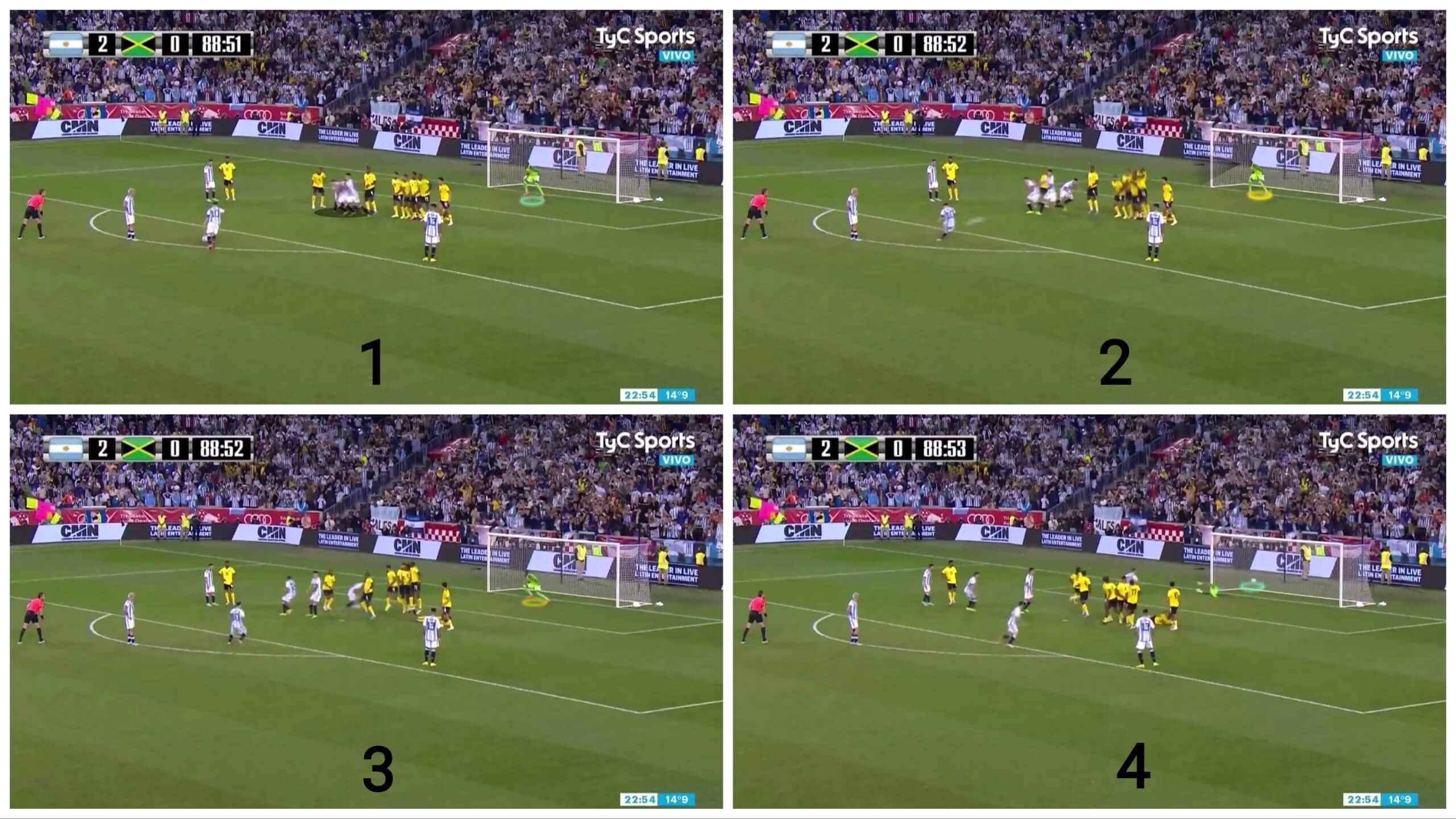
In standard cases, goalkeepers take the responsibility of a particular angle, leaving the other to the wall, standing in the way that makes them see the ball, so if it comes to his angle in his sight, he will deal with that, and if it gets out of his sight, that means that it will be over the wall — in that case, he will move quickly behind the wall, but against the attacking wall, they can’t do that as the ball may be out of sight.
Goalkeepers can’t move early because of this attacking wall, which fixes them to close their near angle, fearful of the previous scenario, especially when the wall pretends to move away when the taker moves, giving goalkeepers a suspicion that the ball would go through the wall towards the near angle.
From this, the opposite idea comes; making the attacking wall pretend that the ball would get through while the taker kicks the ball over the defending wall — let’s get into the details of that.
In the first photo, the attacking wall stands in the path of the goalkeeper’s sight. In the second photo, when Messi gets close to the ball, a player from the wall moves away, pretending that the near post is the target, and also to get the rebound. This takes the attention of the goalkeeper, as in the third photo, who can’t move until he assures that the ball won’t go to the near post. He starts to move late when the ball passes the defending wall, as in the fourth photo.
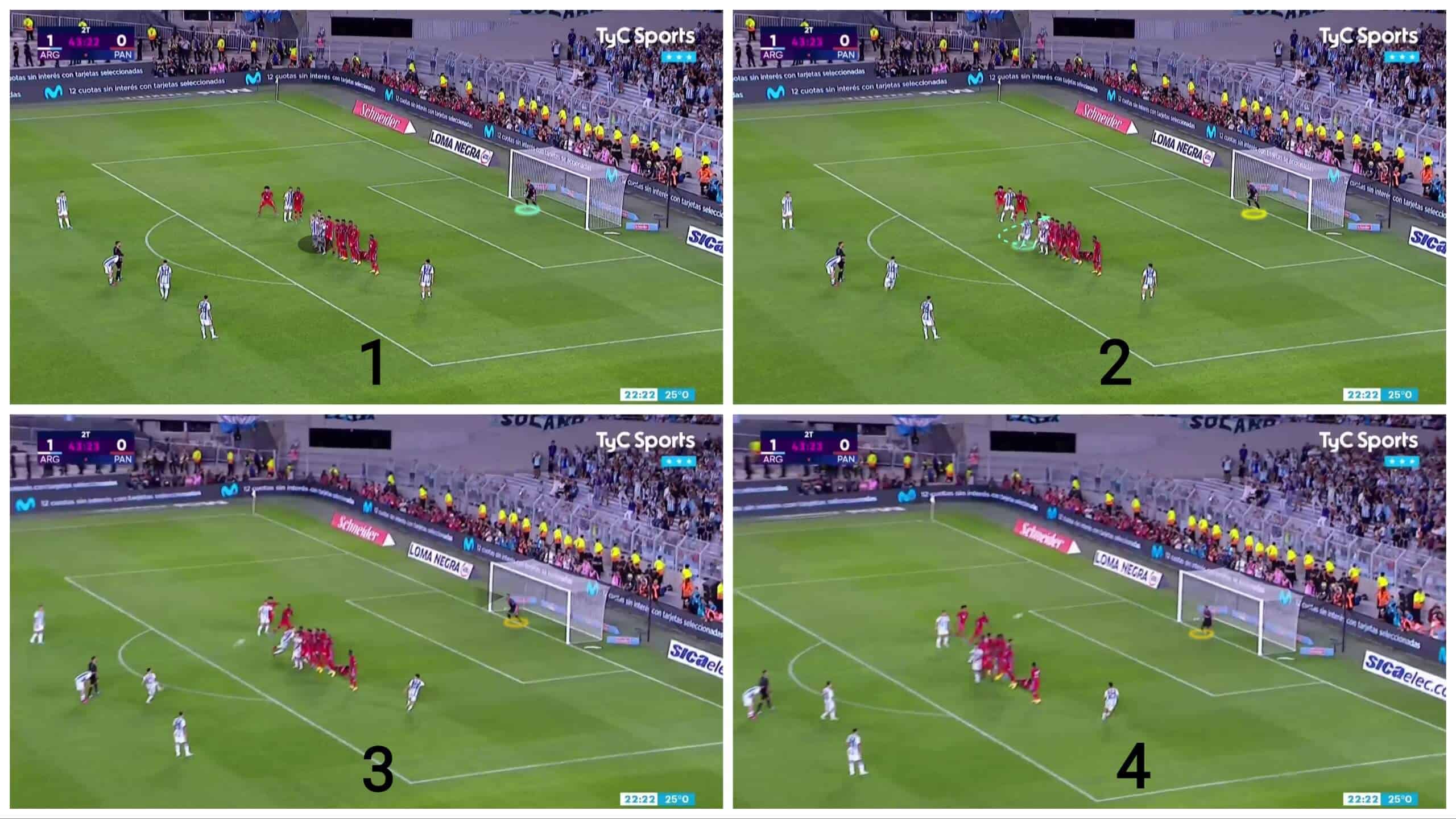
The result is a goal, as shown below. An important note here is we can’t neglect Messi’s incredible technicality and talent, but this trick is still an assisting factor in the goal.
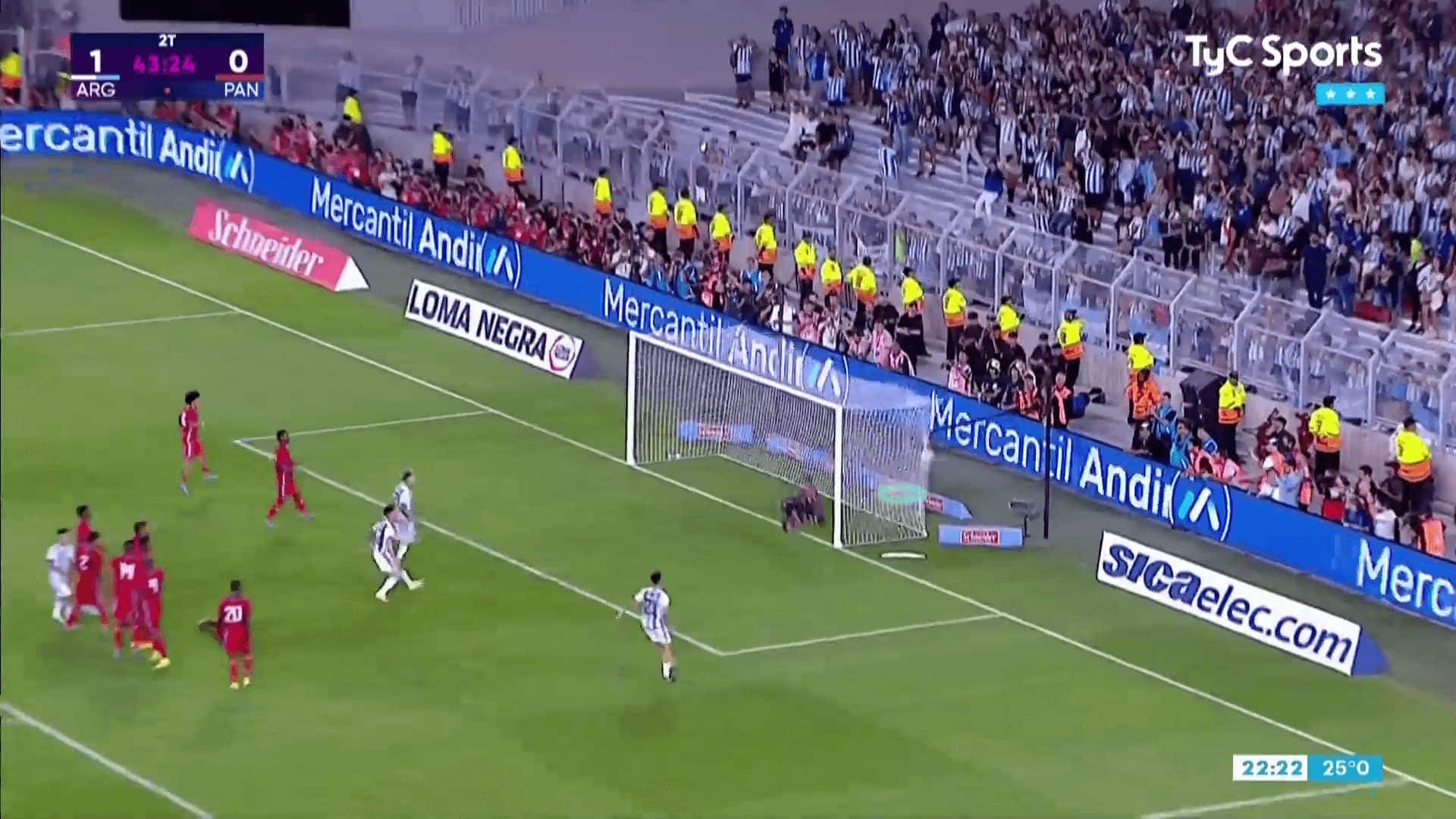
When you have terrific takers who can kick the ball powerfully in the goalkeeper’s angle and chip the ball over the wall, it is an advantage with the help of the wall. We can also notice this with Cristiano Ronaldo, as shown below.
In the first photo, the attacking wall blocks the goalkeeper’s sight, then moves when Ronaldo touches the ball while the goalkeeper still sees nothing, as shown in the second photo. He begins to see the ball when it passes the attacking wall, and the result is a goal.
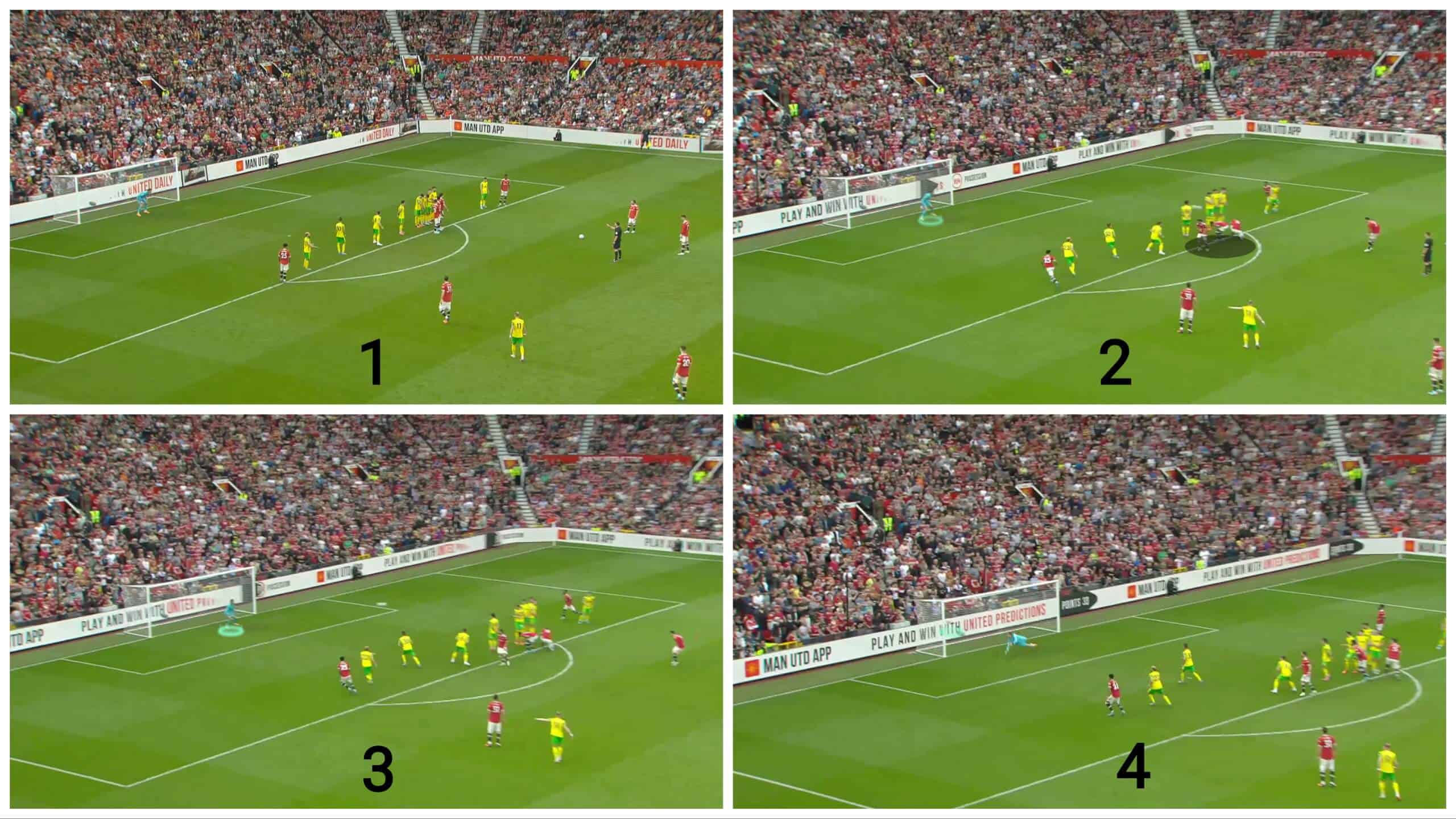
Ronaldo can also use the opposite idea depending on fixing the ball in his place, afraid of the attacking wall’s angle while he plays the ball over the defending wall. In this case, he doesn’t have to put the ball into the top corner because the goalkeeper’s reaction became late, so he just needs to put the ball over the wall.
In the first photo below, Pepe insists on standing beside the defending wall with his teammate forming the attacking wall. At the same time, Ronaldo also points with his finger, which sews doubt in the goalkeeper, who doesn’t move until the ball passes the defending wall. The result is a goal.
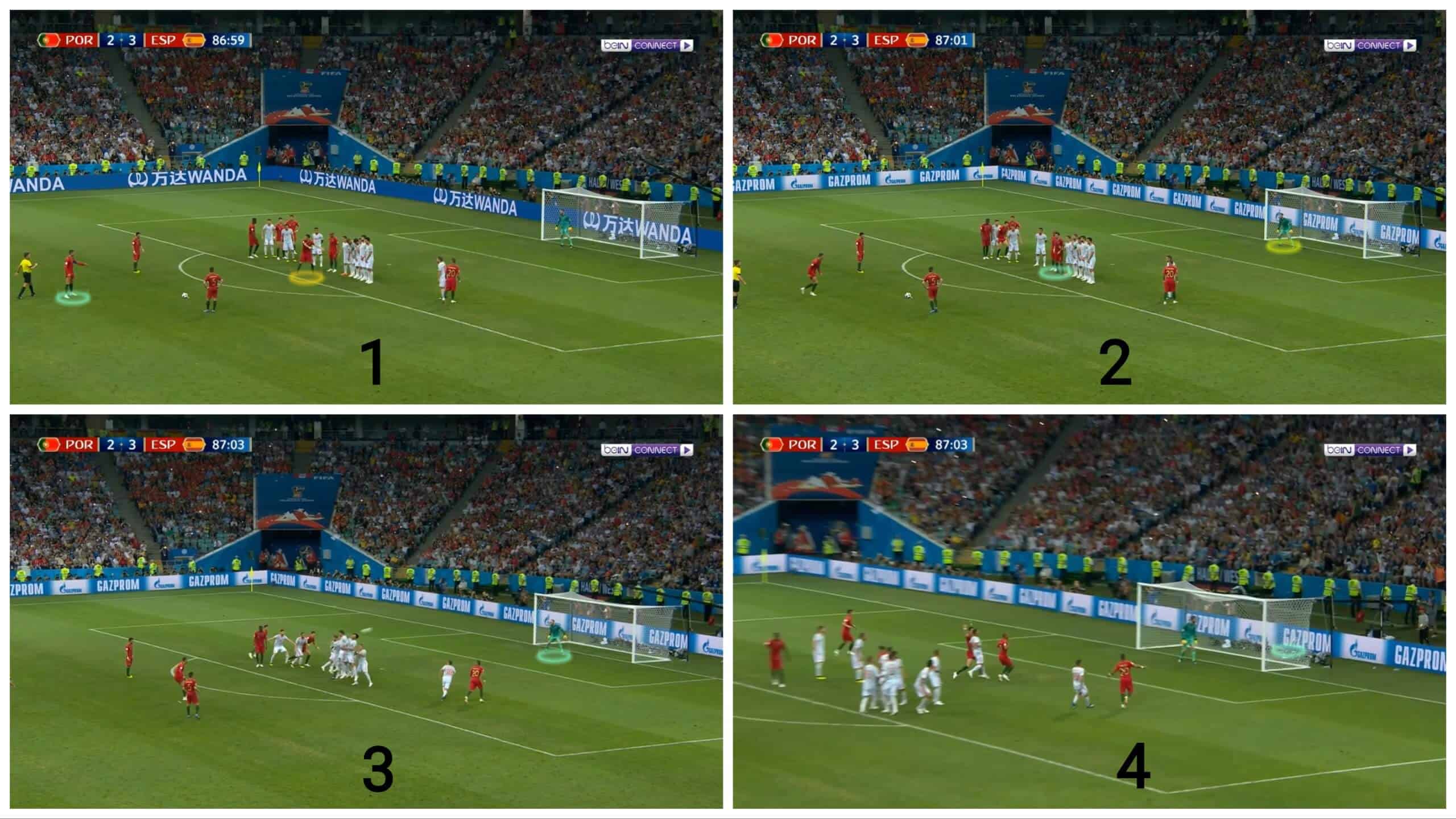
But what would they do if the attacking team doesn’t have a fantastic taker, like Messi and Ronaldo, who can shoot powerfully into the goalkeeper’s angle and chip the ball over the wall simultaneously?
Two takers
Most teams don’t have such a fantastic player who can technically shoot firmly and chip the ball at the same time, so they rely on using two takers standing over the ball.
Brentford use Ivan Toney and Bryan Mbeumo as two takers. Toney is incredibly excellent at powerful shots, while Mbeumo is excellent at chipping the ball over the wall, which puts the goalkeeper against all the possibilities.
In the case below, we show the first possibility — Toney’s rocket shot through the attacking wall. Toney strikes the ball while the goalkeeper is still trying to see the ball, so he doesn’t see Toney’s rocket until the ball passes the attacking wall, as shown in the third photo, and the result is a goal.
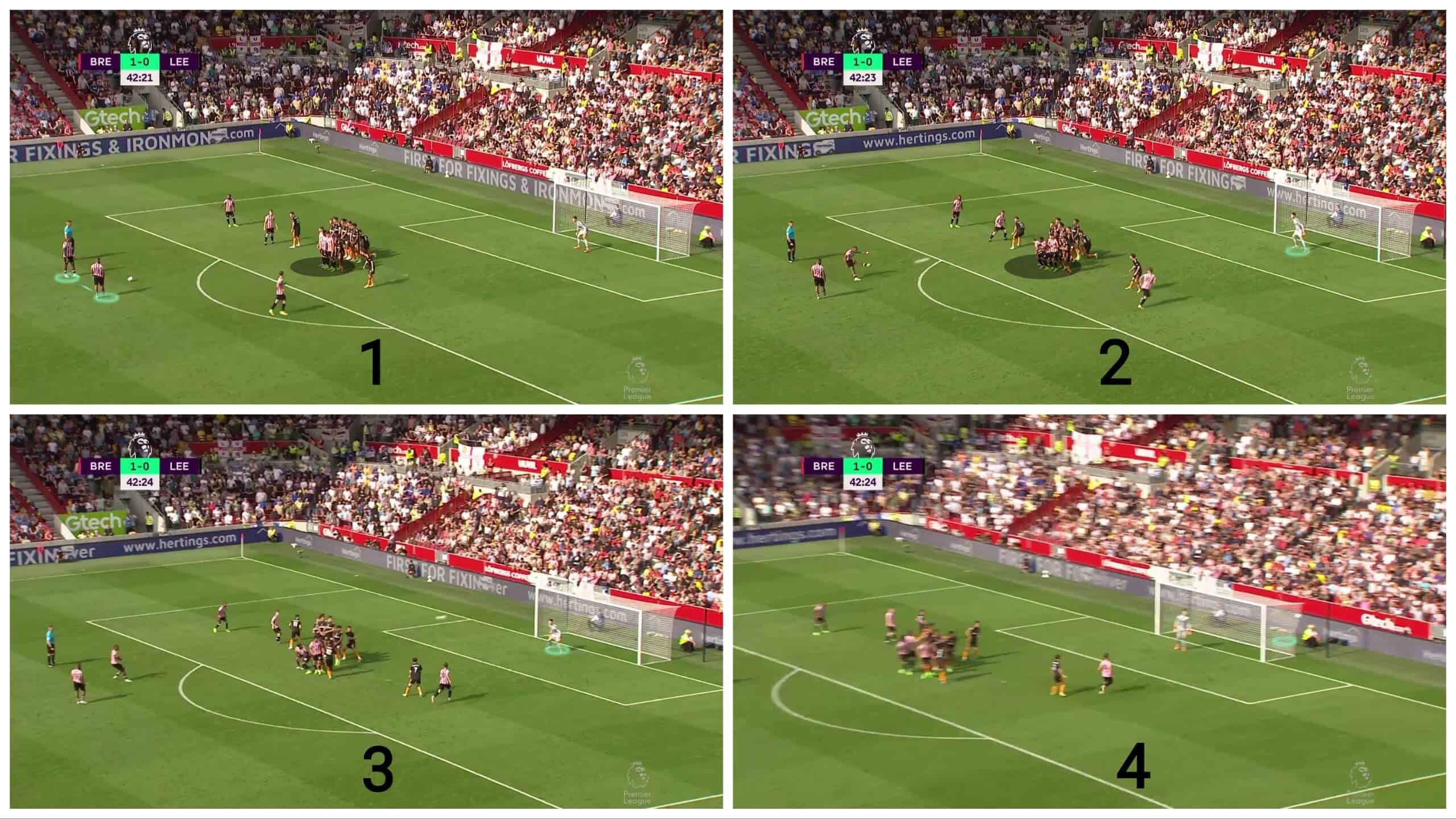
In the case below, we come to the second possibility, which is Mbeumo’s chip over the defending wall, exploiting that the goalkeeper can’t decide to leave his angle until he sees the ball, which is so tricky because of the attacking wall so that you can see this game of chess.
The attacking wall blocks the sight of the goalkeeper, so Mbeumo touches the ball. In contrast, the goalkeeper sees nothing and, at the same time, is afraid of Toney’s shot through the attacking wall whose players don’t move until the last moment, so he doesn’t move until he sees the ball, and the result is a goal.
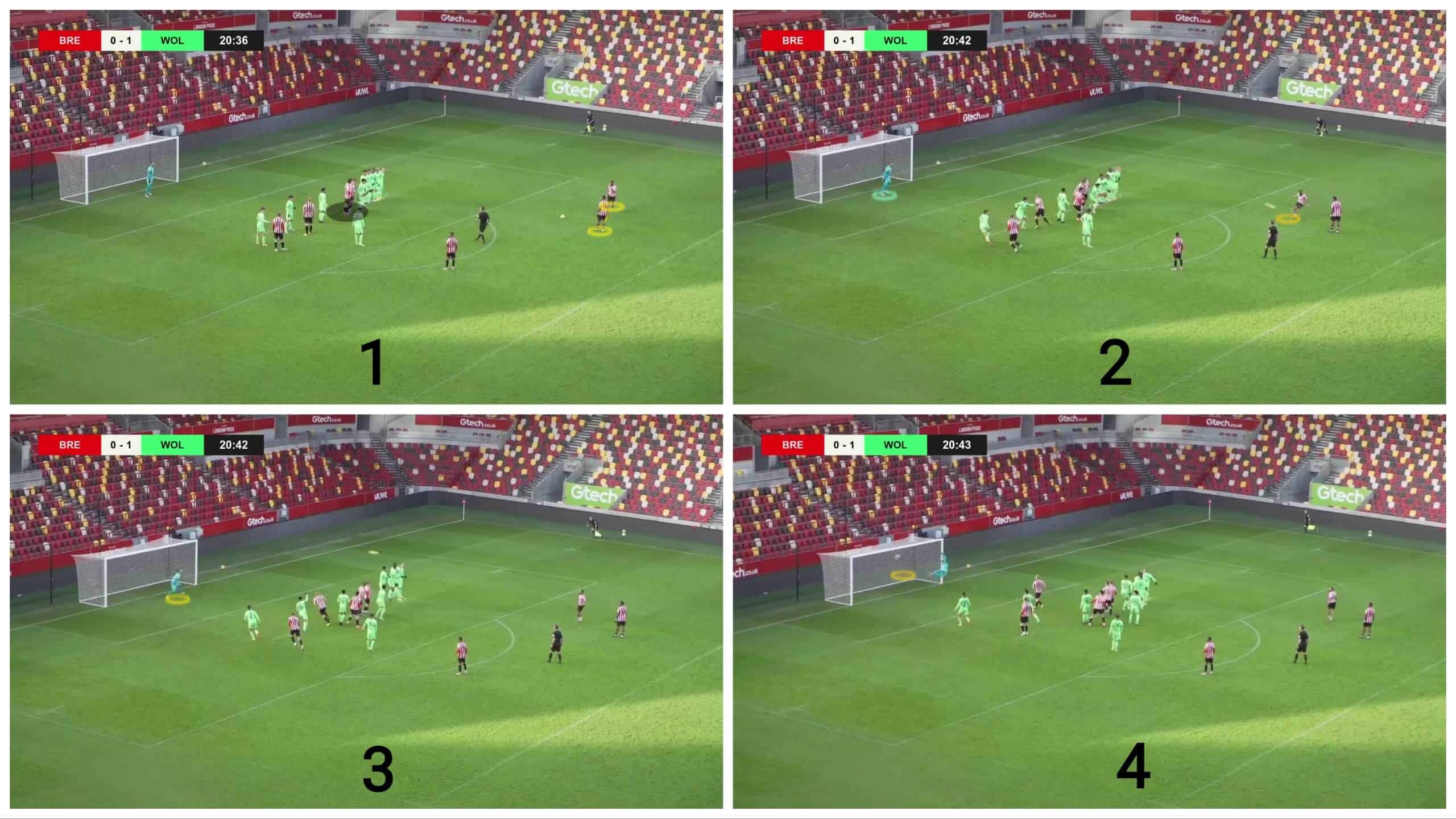
Brentford also uses these two takers in another trick: making Toney shoot the ball while the attacking wall moves, pretending that he would shoot through them, which makes all the defending team give their attention to the goalkeeper’s angle. Still, he shoots in a swerved way beside the defending wall, deceiving the goalkeeper, who reaches late, and the result is a goal.
This trick usually happens when the goalkeeper makes the wall stand, not closing the far angle well, giving more importance to his angle.
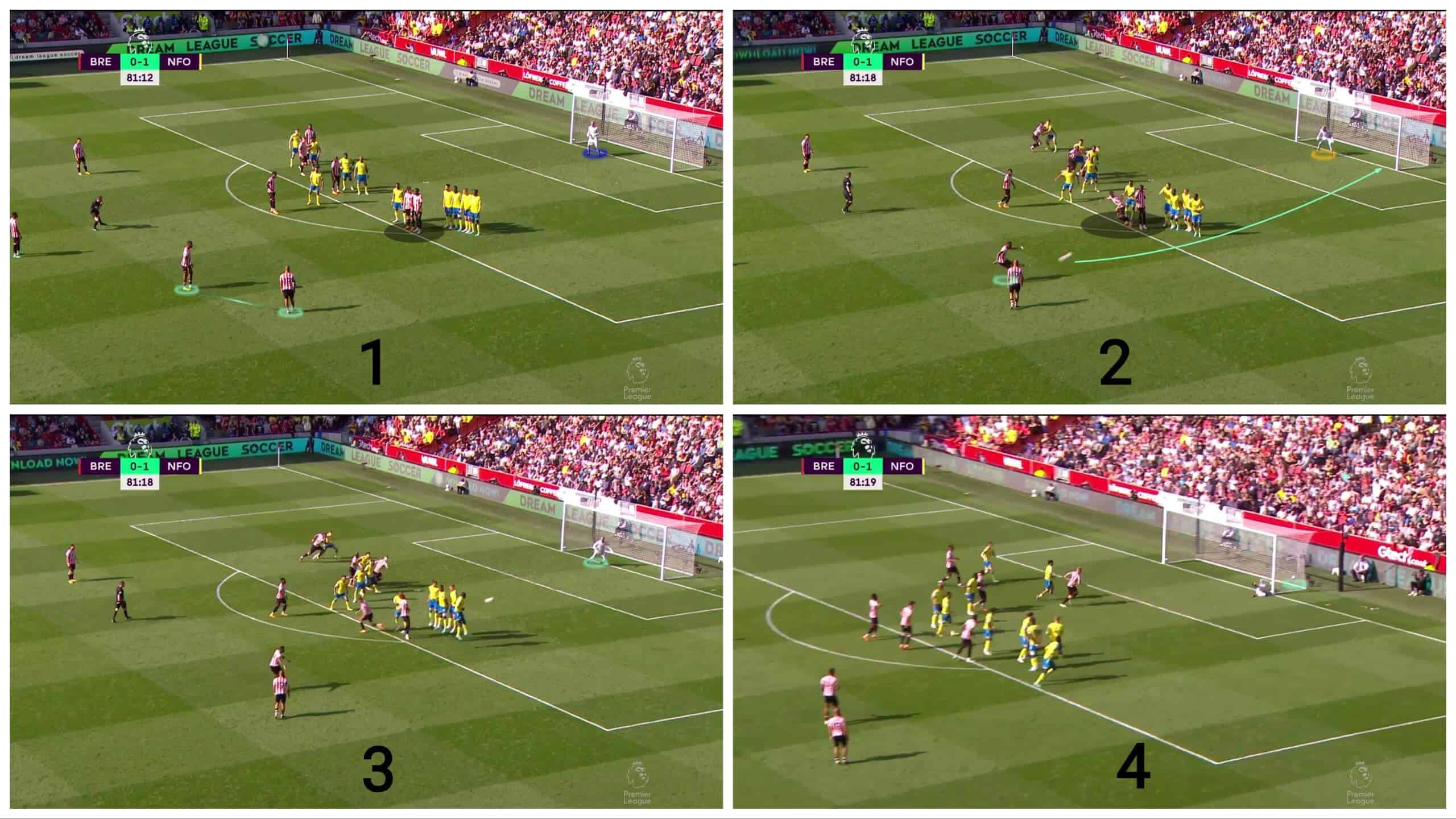
Creating a movement in front of the goalkeeper
It is not only blocking the goalkeeper’s sight, which makes him arrive late to the save but also confusing him by making movements in front of him, manipulating his mind and putting many possibilities in his mind.
Below, one of these tricks to confuse the goalkeeper is putting many players in an initial offside position and then moving as the first taker steps over the ball, which takes the goalkeeper’s attention, wanting to know what is going on.
In the third photo, they form a usual attacking wall to make it difficult for the goalkeeper to see the ball and then decline when it gets closer to make the goalkeeper’s reaction late.
So, we have a double trick here, creating a movement to confuse the goalkeeper and a usual wall to block his sight.
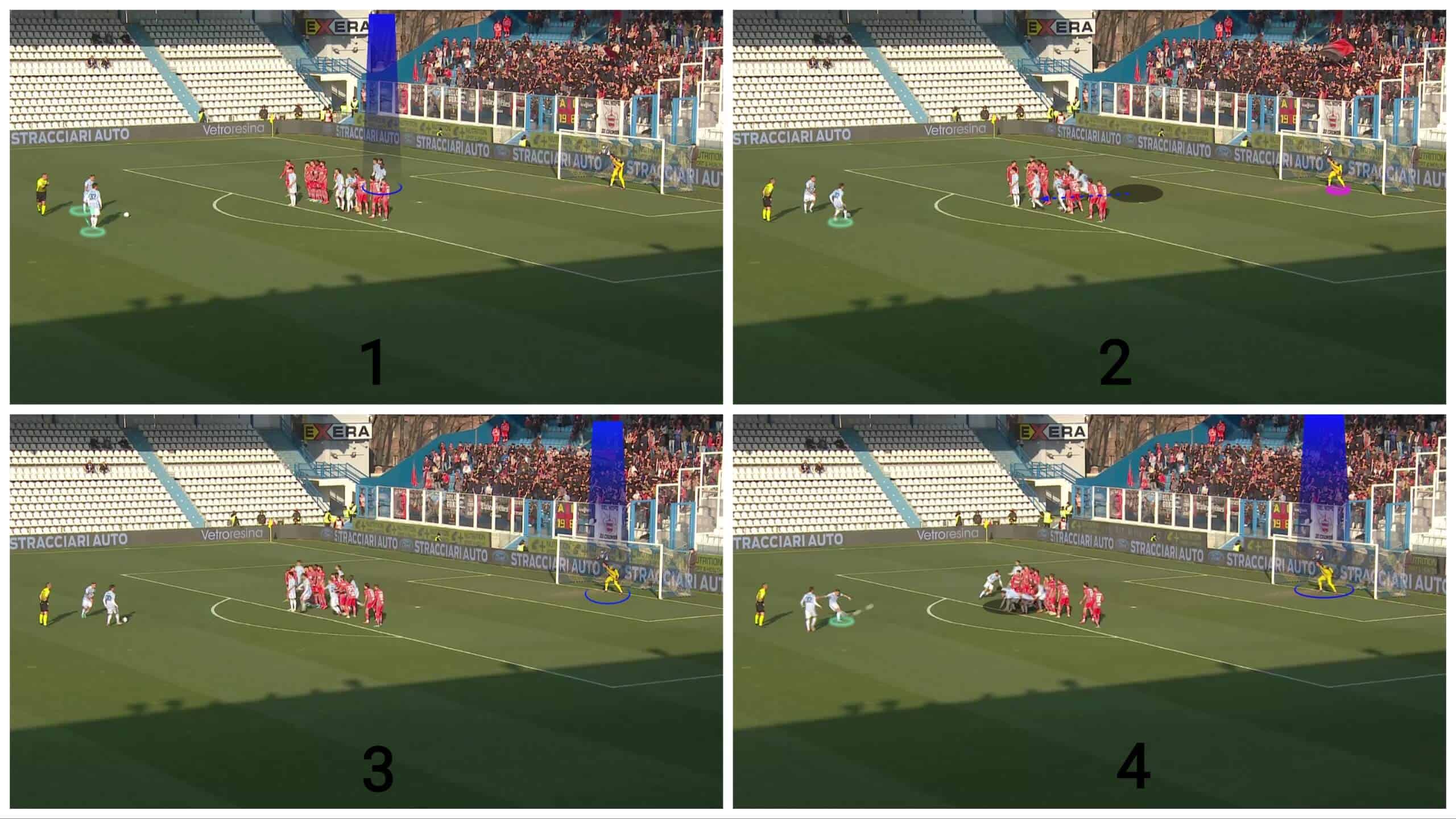
Unfortunately for the attacking side, the shot isn’t good on this occasion.
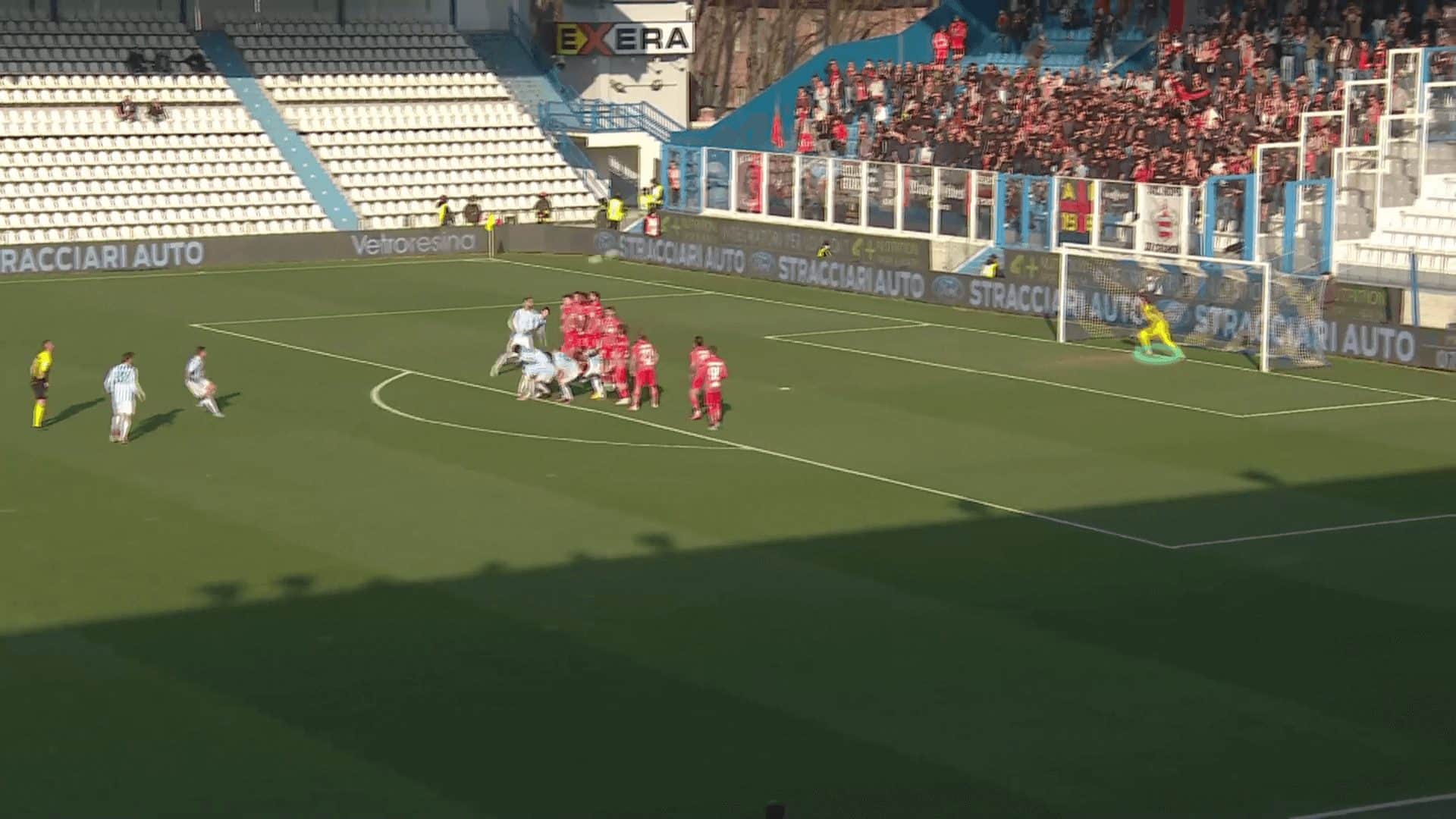
Forming the wall during the routine
There is also a trick of forming the attacking wall during the routine to spoil the scheme the goalkeeper put after arranging his wall, opening a space for him to see and selecting where to stand. Then, suddenly, the attacking team arranges the wall, closing his sight, confusing him and giving the opponent no time to annoy or push them away.
In this case, Tottenham put only one player in front of the goalkeeper, and the other three stand in a far wall. Hence, the goalkeeper asks a player in green to join the defending wall covering the back of the attacking player in blue in case Harry Kane shoots through him.
As Kane moves, the three-player attacking wall moves toward that single-player wall, forming a four-player wall, completely blocking the sight of the goalkeeper targeting the gap between the two defending walls.
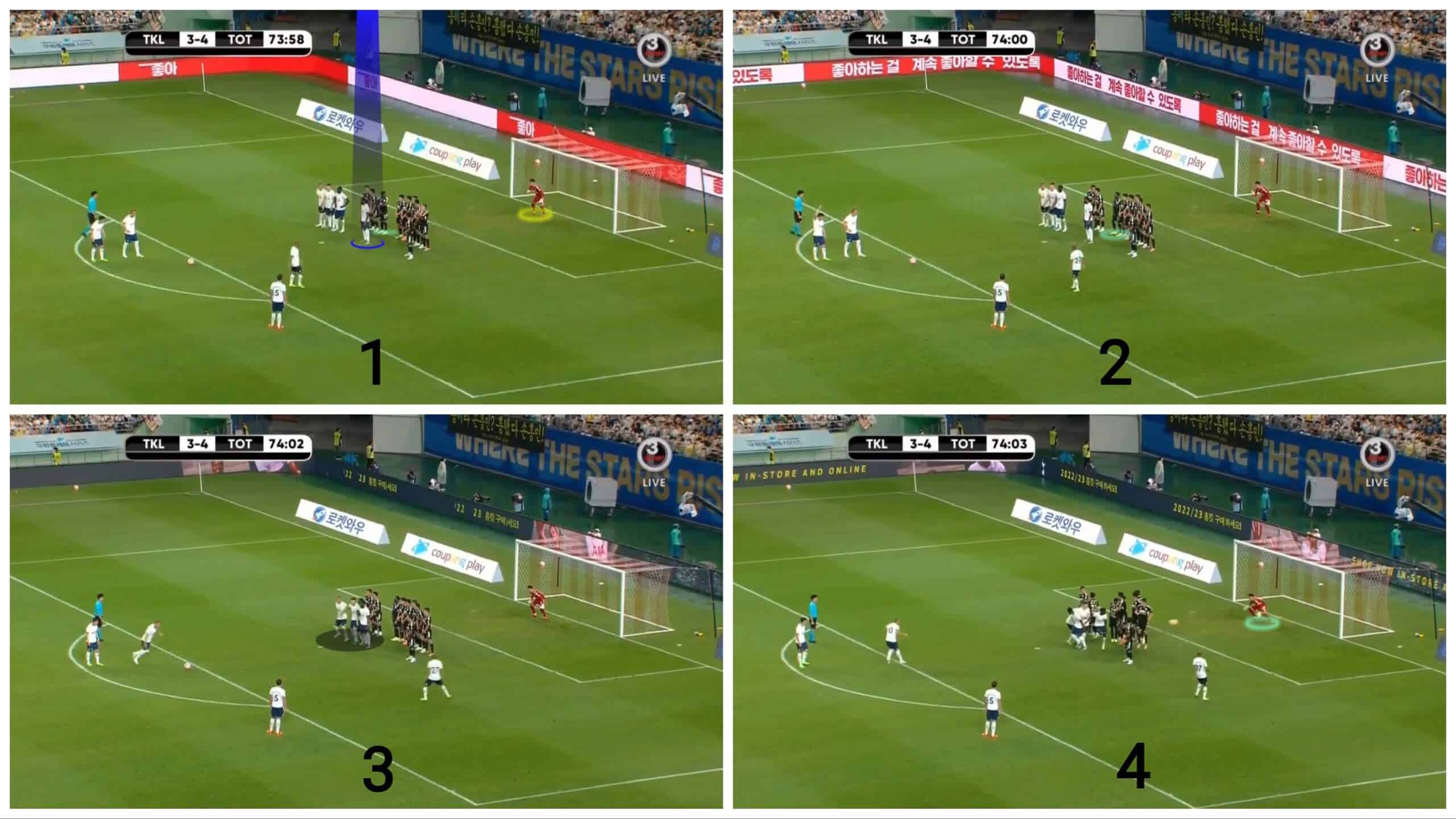
The result is a goal, as shown below.
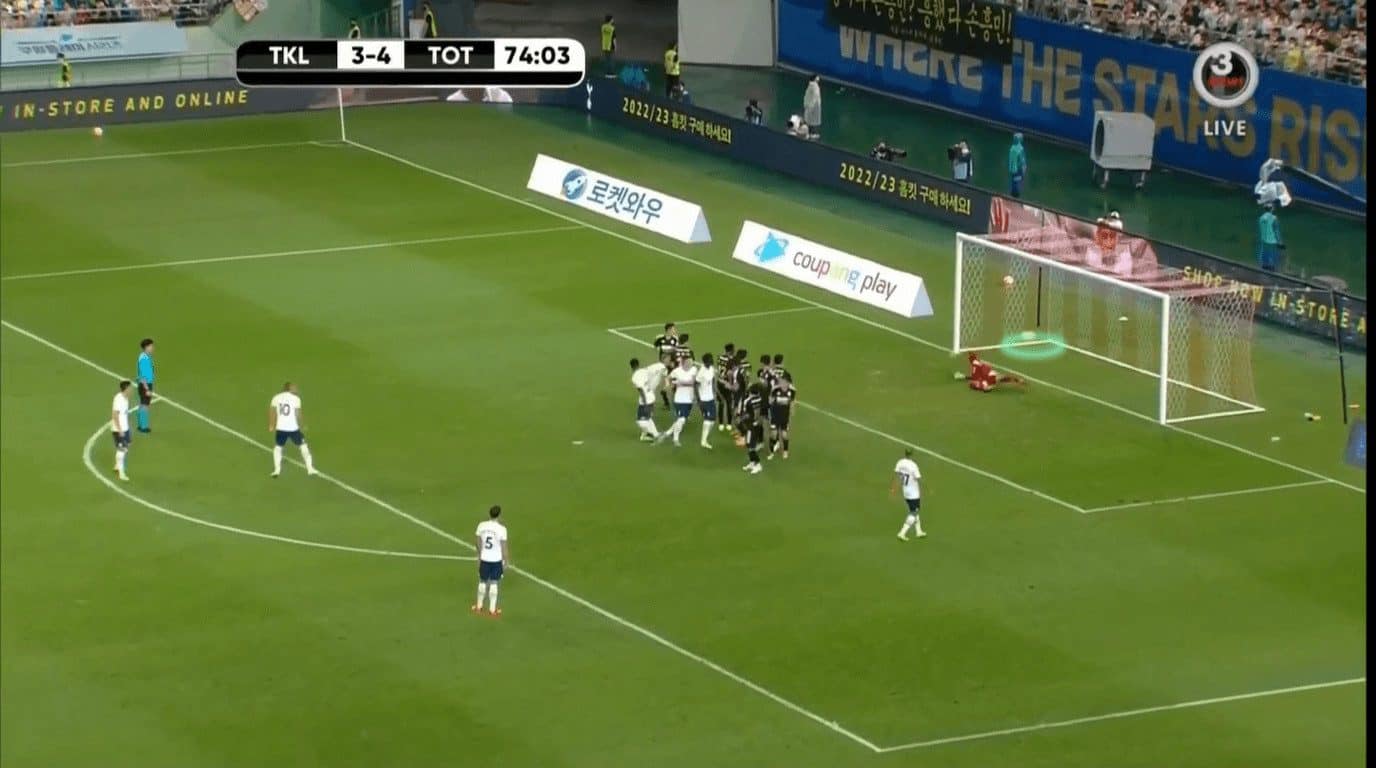
In the case below, the idea is to mislead the goalkeeper into believing the shot would be through the attacking wall. Firstly, the attacking wall starts near the ball. They move back, pretending that they return in the path of the shot and block the goalkeeper, and they form the wall in the end, which you can see as the goalkeeper steps to his left.
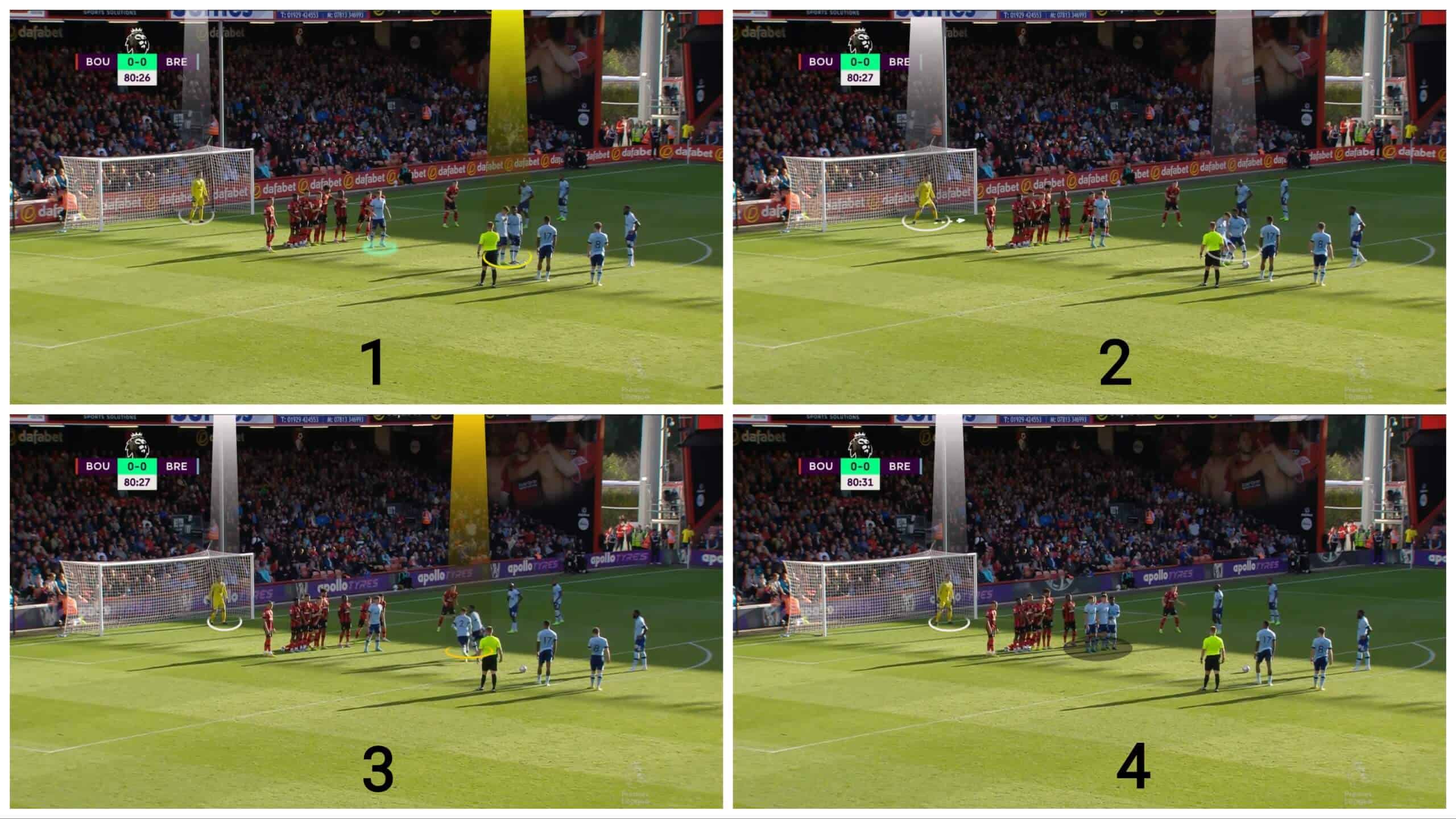
When the taker touches the ball, they get inclined to deceive the goalkeeper for the second time, who is still standing in his place while the ball is far from them, aiming to get it up and down, over the wall.
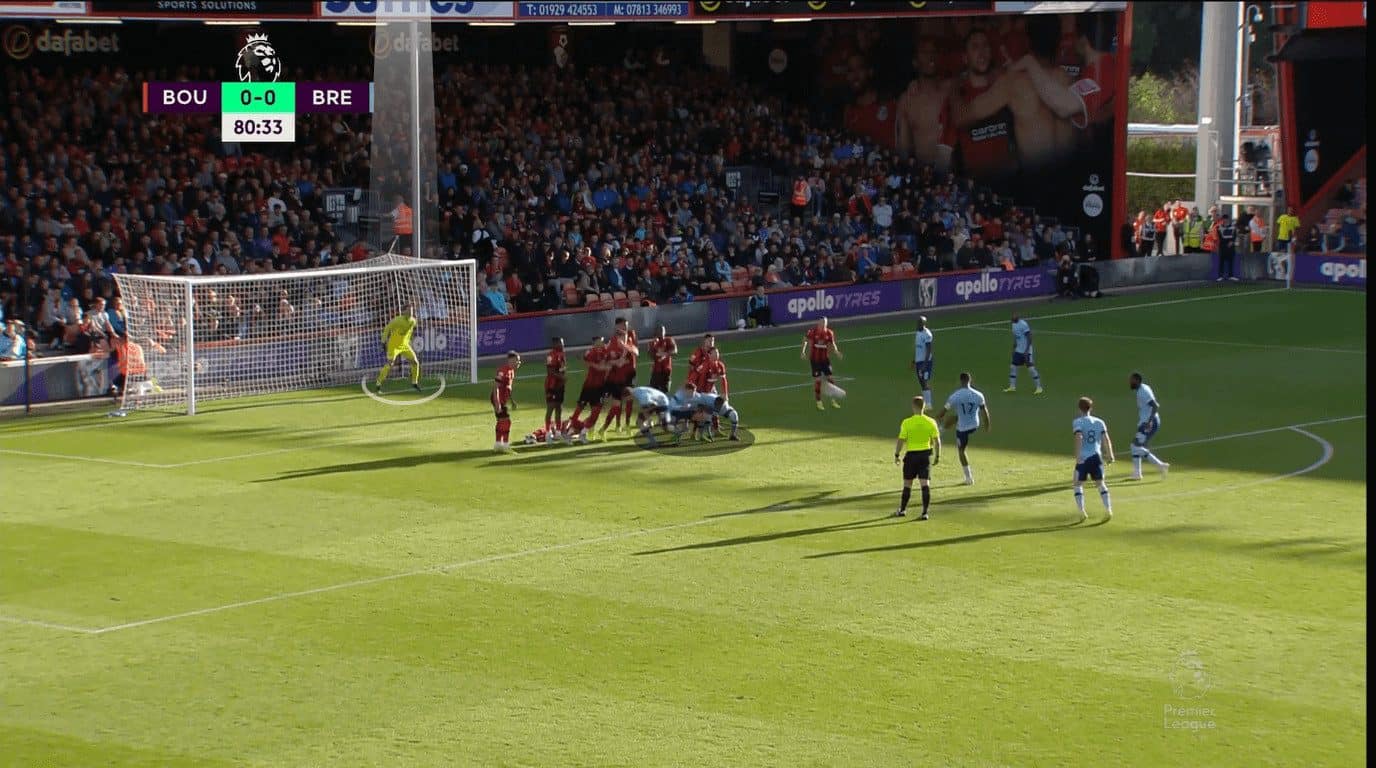
The shot hits the defending wall, but you can notice the reaction from the goalkeeper.
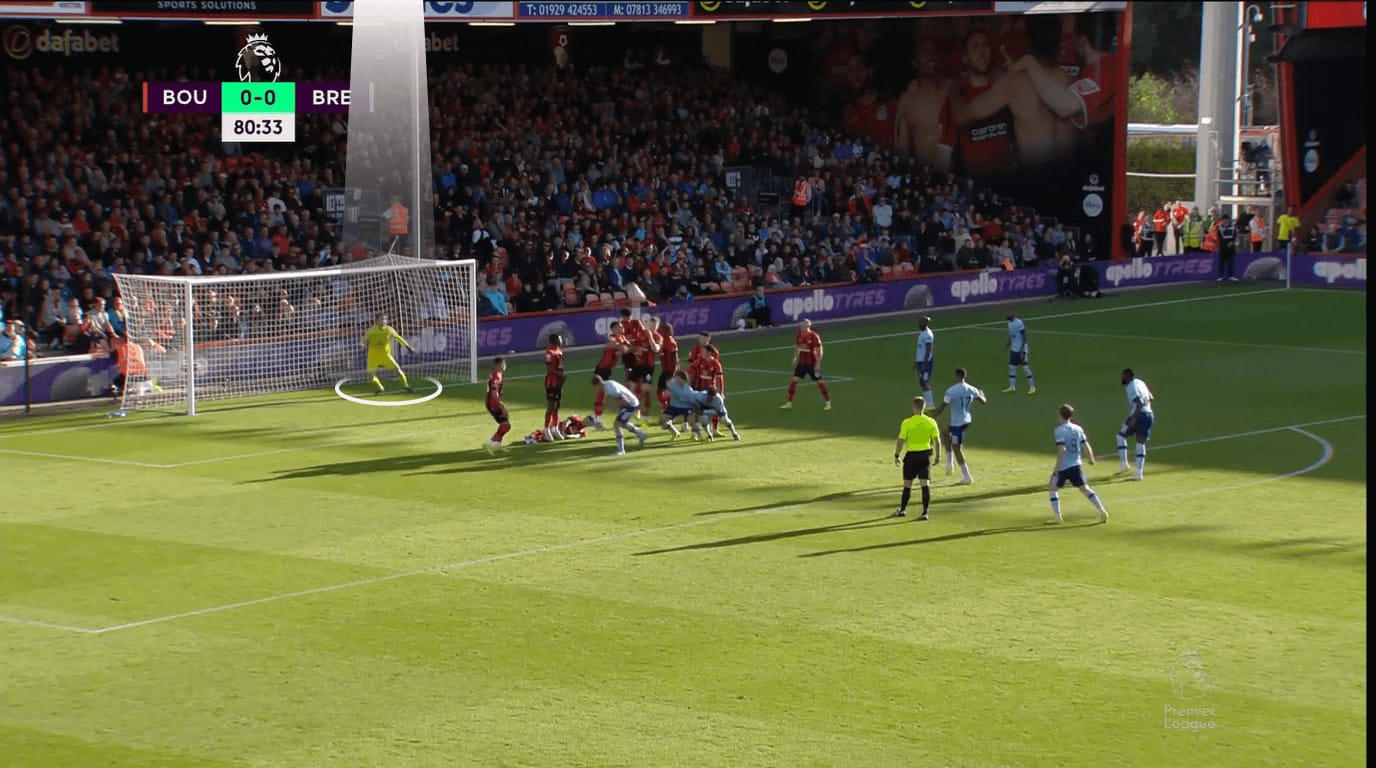
An offside wall
Many teams use the offside wall, which can irritate defenders and confuse goalkeepers.
Initially, you can see that the attacking wall stands in an offside position, but when Son Heung-min raises his hand, they move to be onside. This movement attracts the goalkeeper’s attention and also blocks his sight, so the ball moves, and he still doesn’t see it.
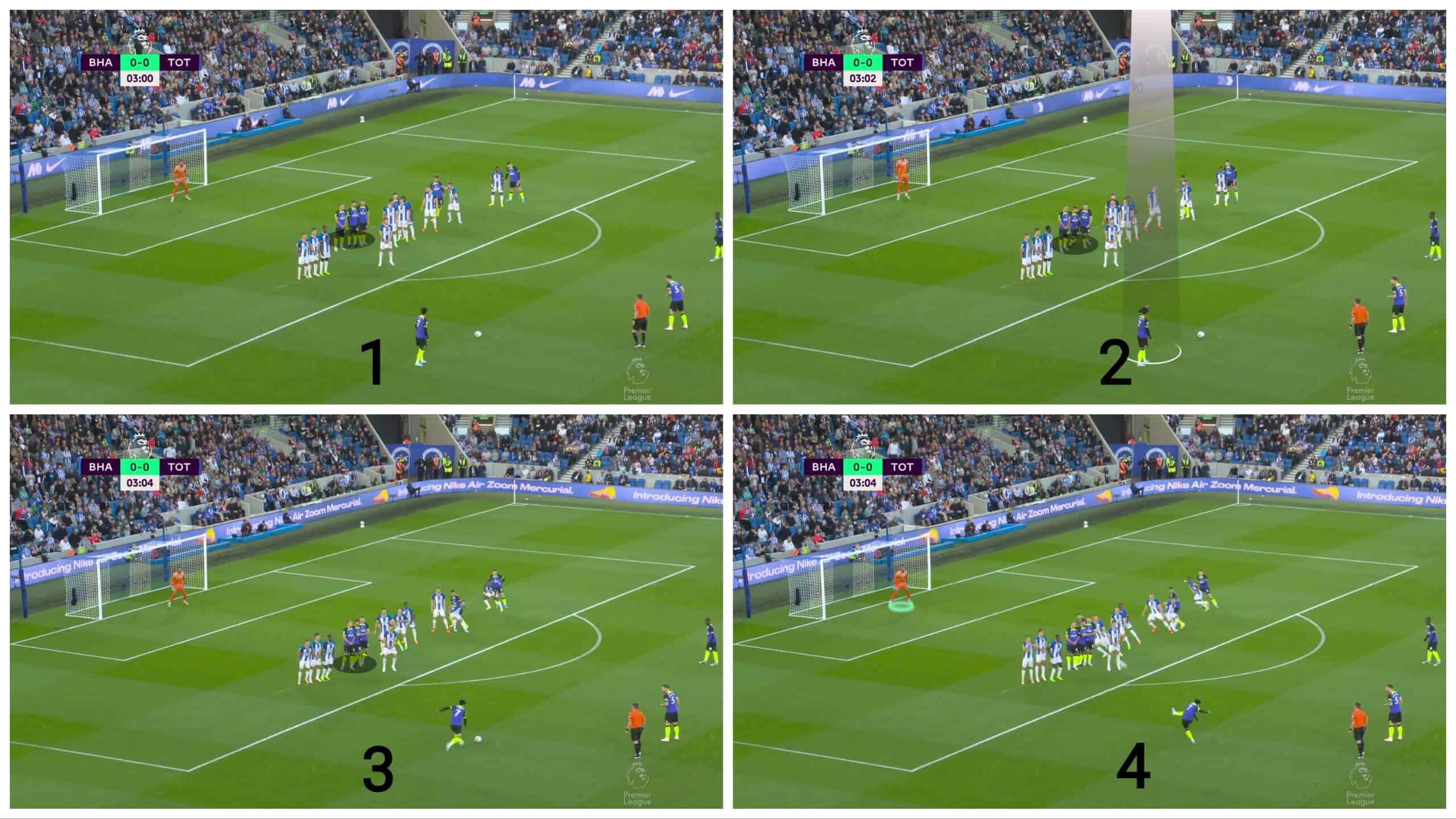
As shown below, he starts to move late when he sees the ball.
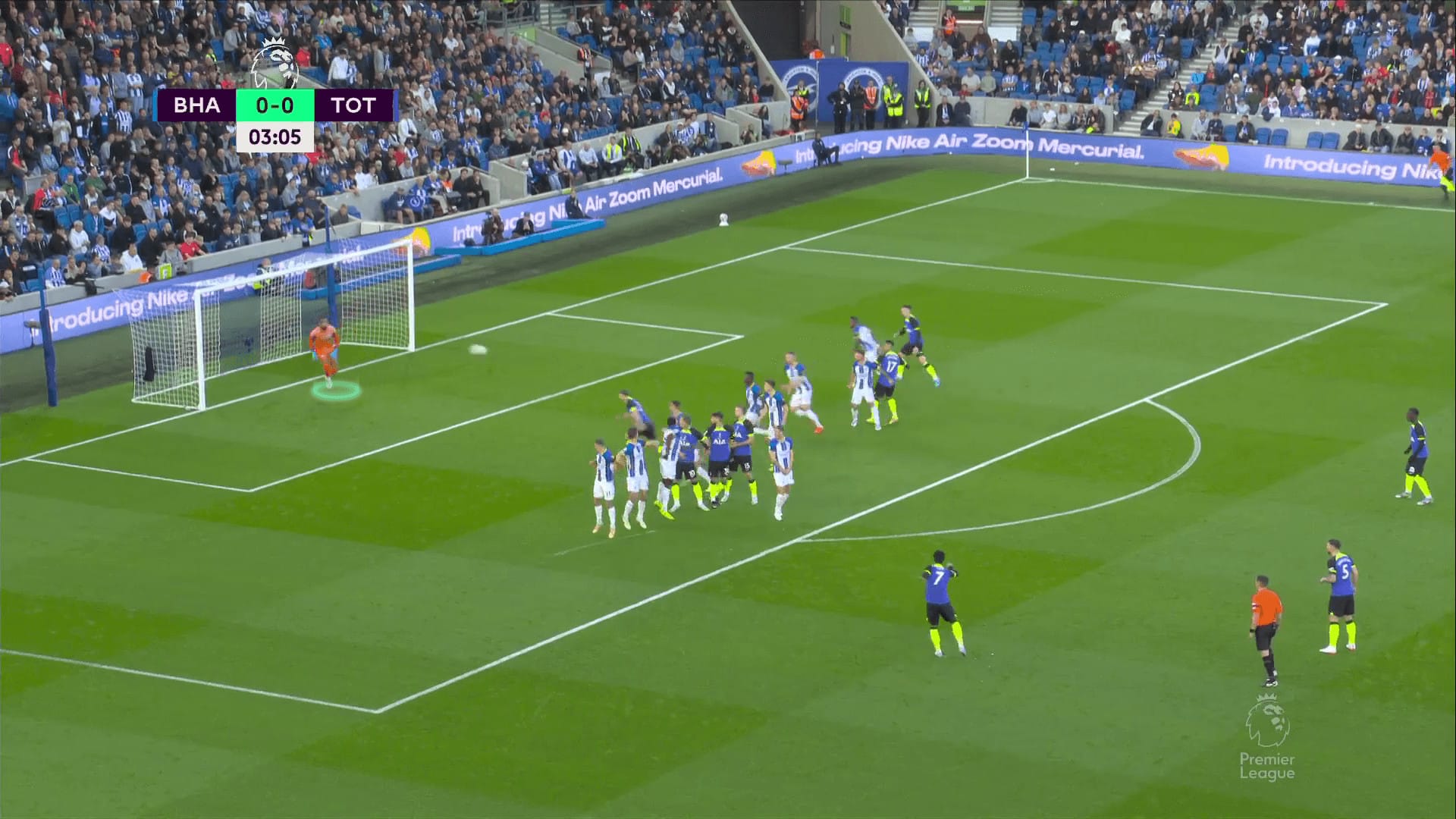
But the shot is weak so he can, ultimately, still get to it.
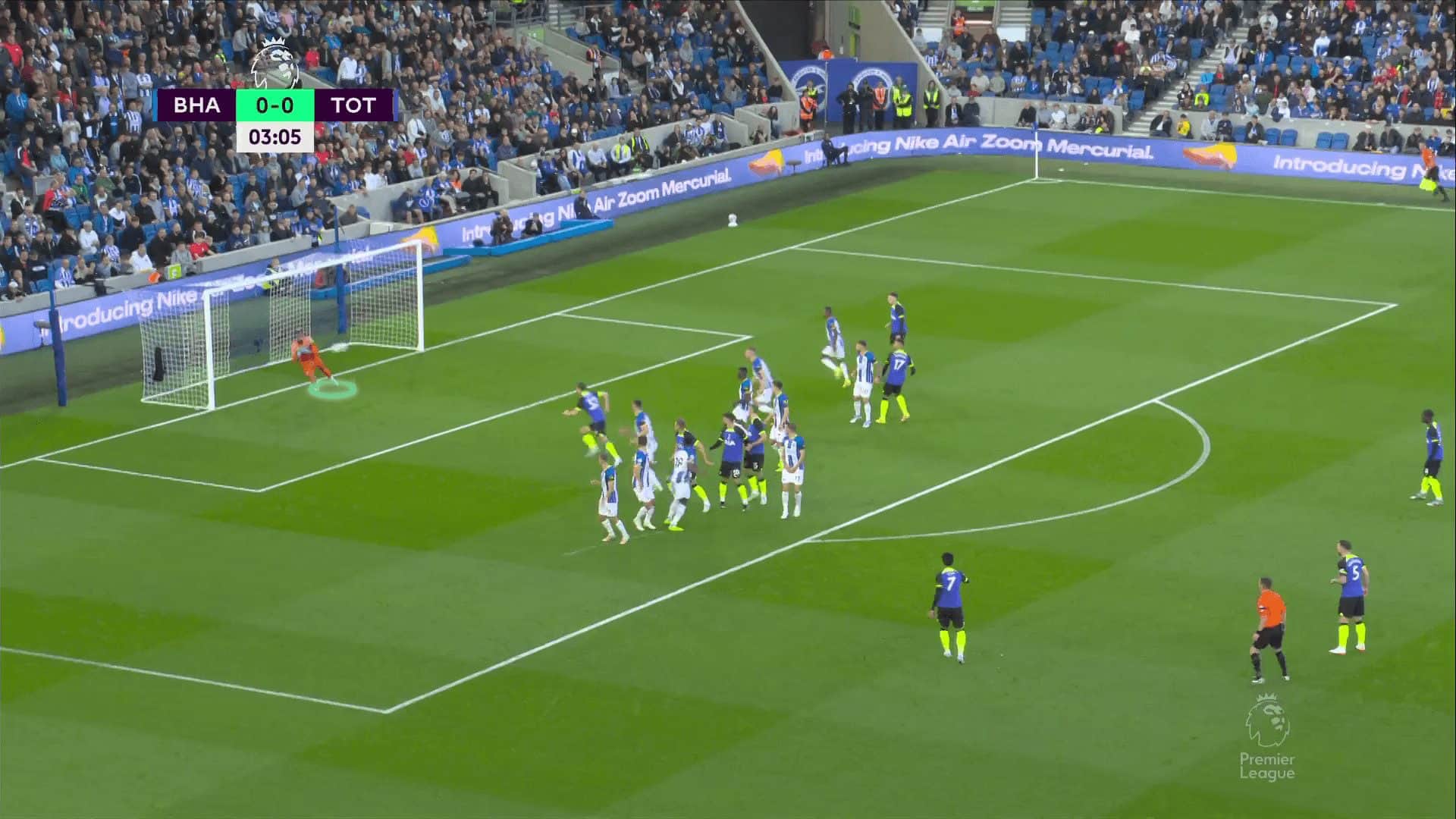
Italy’s combined ideas
Gianni Vio designed plenty of routines with many of our previously-mentioned strategies with Italy, which helped them emerge victorious from UEFA Euro 2020.
In the first photo below, you can see a usual wall, an offside wall and two takers while you see that the goalkeeper gives his attention to the offside wall. Secondly, we come to another principle, which is creating movement in front of the goalkeeper, and we should concentrate on tracking everyone’s role in this offside wall after their movement.
In the third photo, when the first taker steps over the ball, the pink-highlighted player drops to be onside, before moving to get the rebound from the goalkeeper; the yellow-highlighted player tries to push the defending player beside the wall because he is in the shot path and the blue-highlighted player acts as he drops back to receive a chipped through pass behind the ball attracting the goalkeeper’s attention, as shown in the fourth photo when the goalkeeper recognises that it is a trick trying to get back to his correct position.
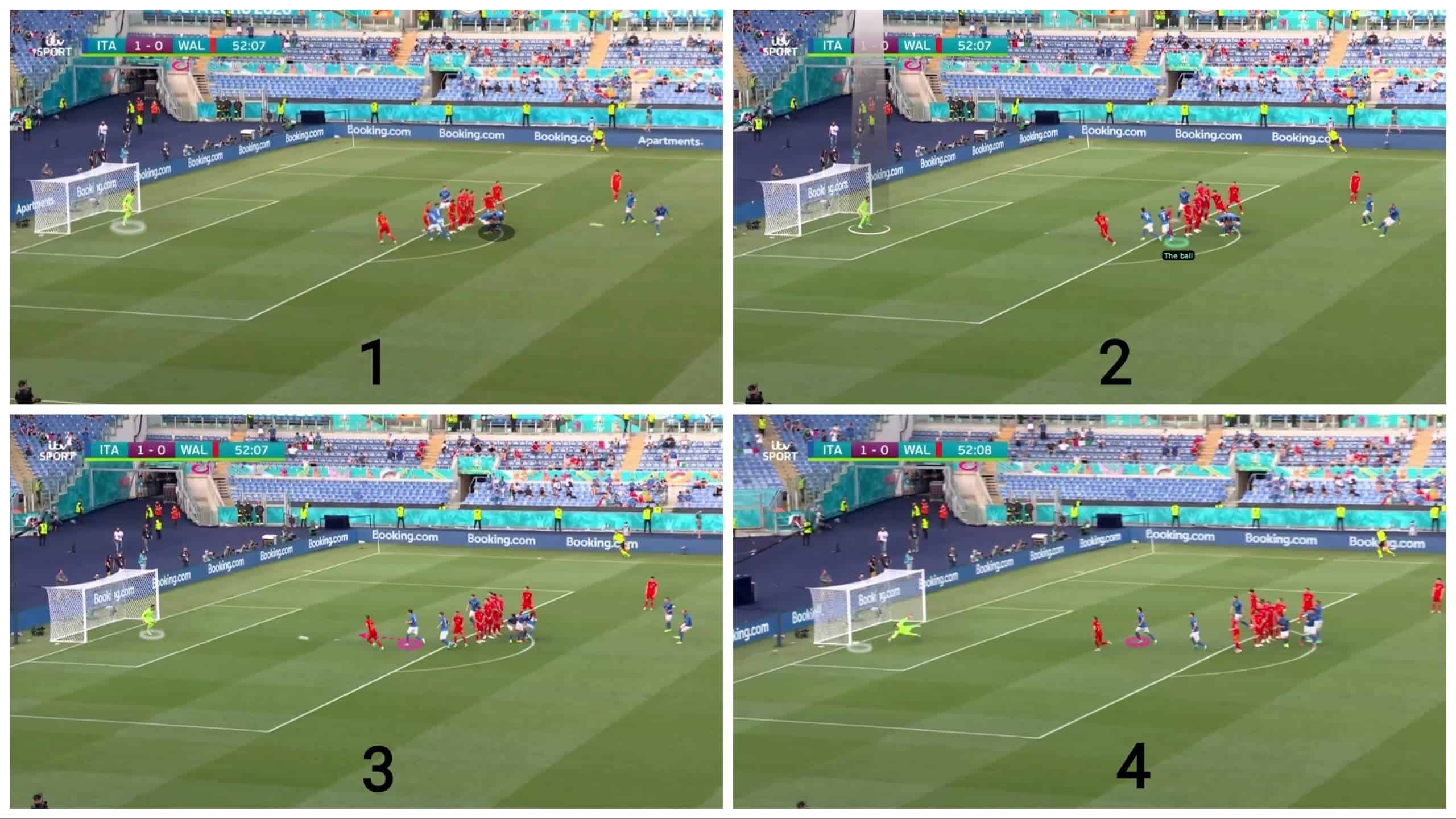
We are still in this complicated routine, and below, we see another trick shown by the standard wall whose players get inclined to deceive the goalkeeper while the shot passes by them. All of that makes the goalkeeper’s reaction late, but the ball hits the post.
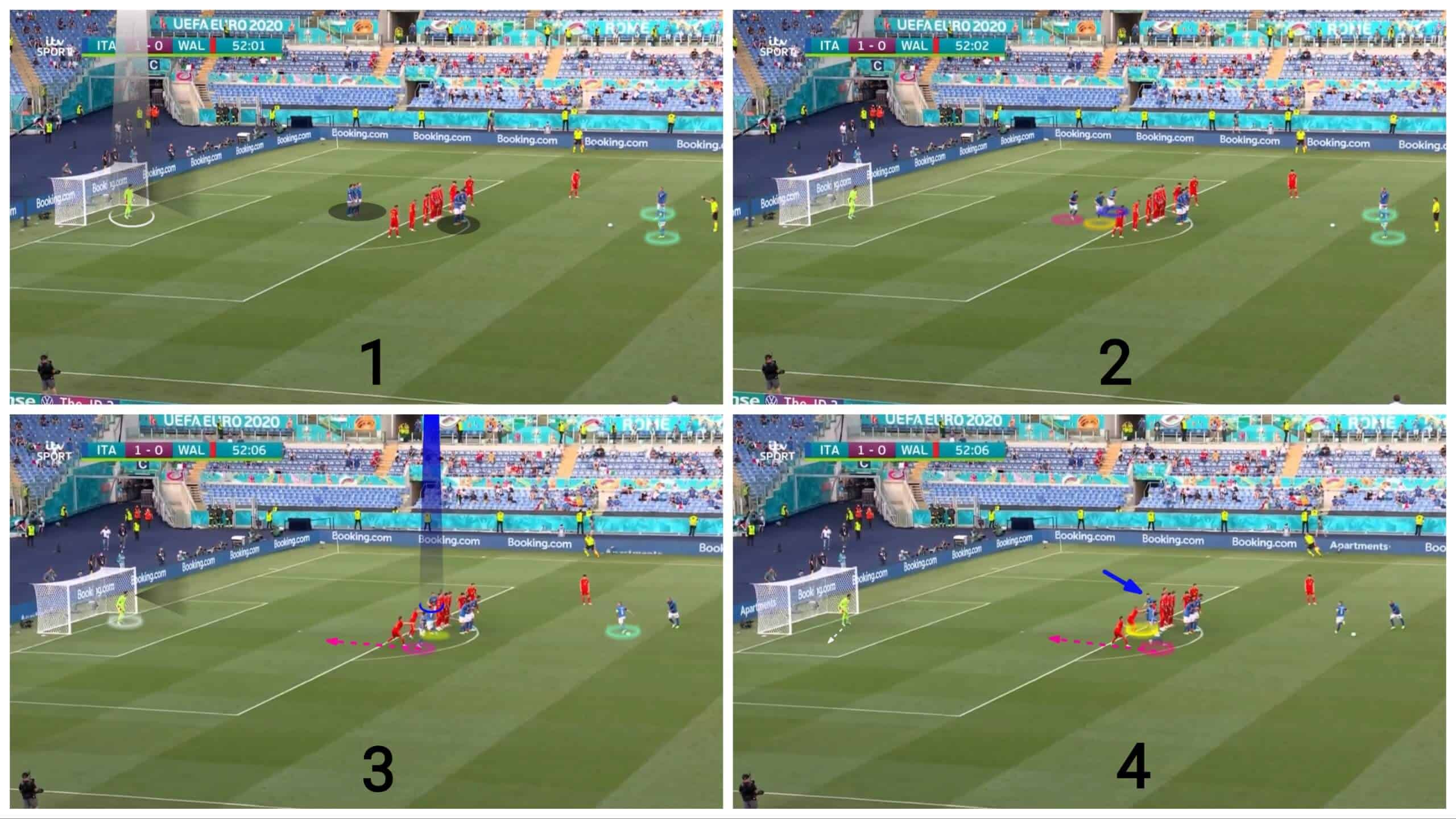
In the first photo, we can see a different idea by using two walls in front of each other.
In the second photo, when the taker moves, the first wall moves in different ways to distract the goalkeeper, while the second wall is the normal one to block the goalkeeper’s sight, as shown in the third and fourth photos.
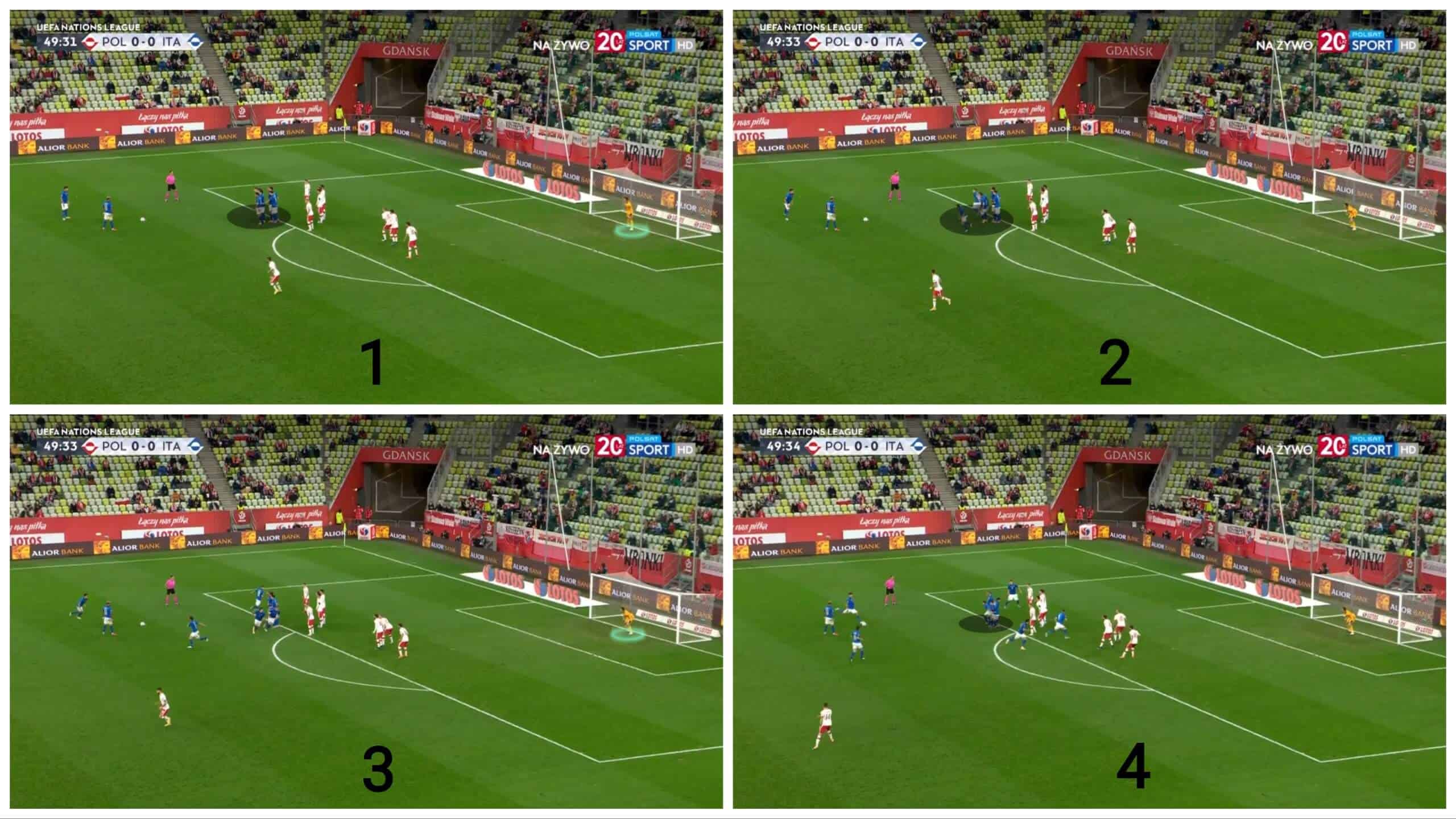
But the ball hits the defending wall.
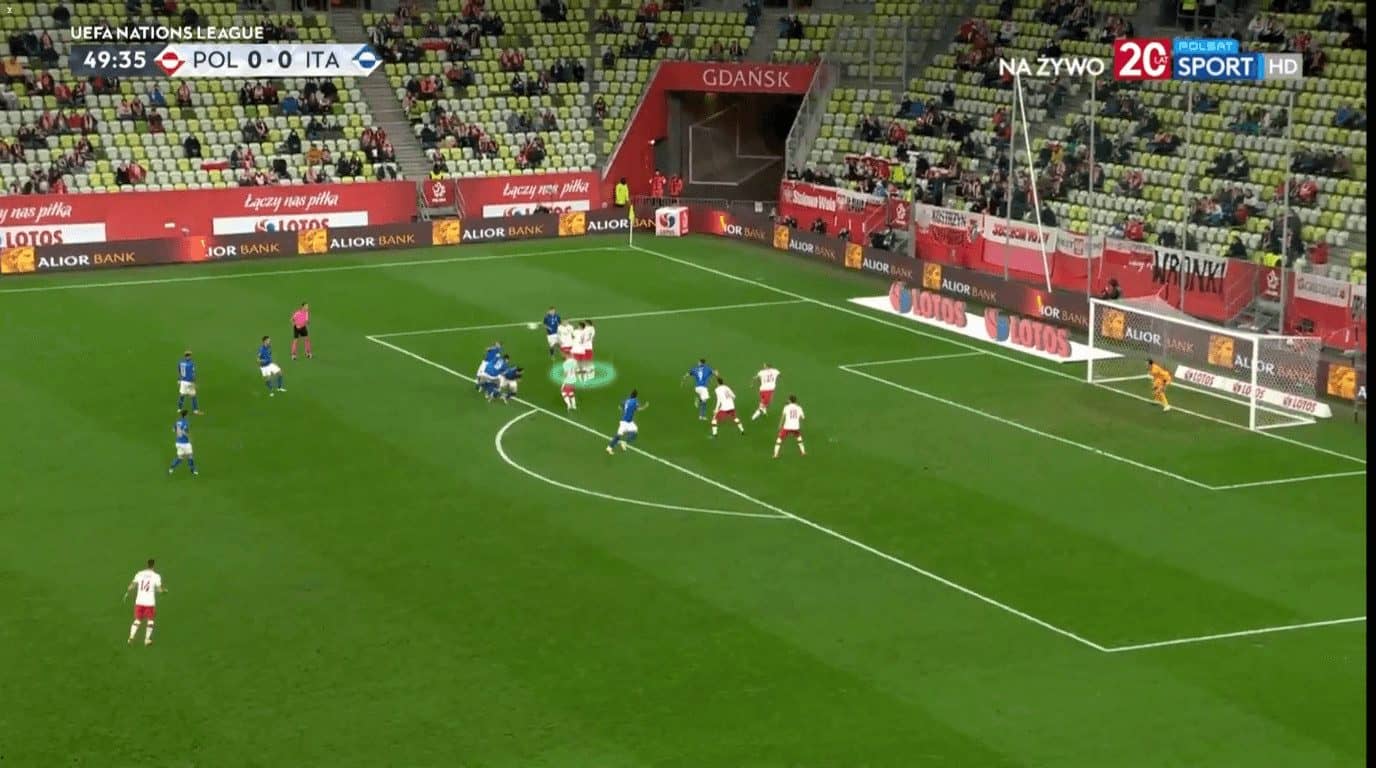
Conclusion
In this analysis, we have shown many ways to distract the goalkeeper and block his sight to make his reaction late, which helps takers score or seriously test the ‘keeper without having to be accurate enough to hit every shot into the top corner.






Comments